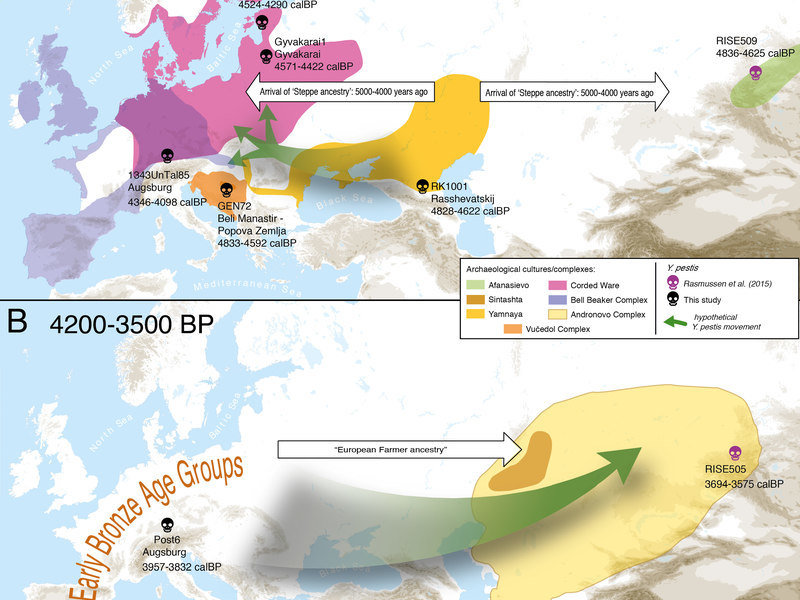Angela
Elite member
- Messages
- 21,823
- Reaction score
- 12,329
- Points
- 113
- Ethnic group
- Italian
Here is the paper on the plague during the steppe migrations whose content was leaked by Krause himself.
http://www.cell.com/current-biology/fulltext/S0960-9822(17)31328-3
To understand the effect on MN and LN Europe I really want to see the exact location and timing of these samples. Does anyone have access to the whole paper?
The Stone Age Plague and Its Persistence in Eurasia
Aida Andrades Valtueña Alissa Mittnik Felix M. Key Wolfgang Haak Johannes Krause
Yersinia pestis, the etiologic agent of plague, is a bacterium associated with wild rodents and their fleas. Historically it was responsible for three pandemics: the Plague of Justinian in the 6th century AD, which persisted until the 8th century [ 1 ]; the renowned Black Death of the 14th century [ 2, 3 ], with recurrent outbreaks until the 18thcentury [ 4 ]; and the most recent 19th century pandemic, in which Y. pestis spread worldwide [ 5 ] and became endemic in several regions [ 6 ]. The discovery of molecular signatures of Y. pestis in prehistoric Eurasian individuals and two genomes from Southern Siberia suggest that Y. pestis caused some form of disease in humans prior to the first historically documented pandemic [ 7 ]. Here, we present six new EuropeanY. pestis genomes spanning the Late Neolithic to the Bronze Age (LNBA; 4,800 to 3,700 calibrated years before present). This time period is characterized by major transformative cultural and social changes that led to cross-European networks of contact and exchange [ 8, 9 ]. We show that all known LNBA strains form a single putatively extinct clade in the Y. pestis phylogeny. Interpreting our data within the context of recent ancient human genomic evidence that suggests an increase in human mobility during the LNBA, we propose a possible scenario for the early spread of Y. pestis: the pathogen may have entered Europe from Central Eurasia following an expansion of people from the steppe, persisted within Europe until the mid-Bronze Age, and moved back toward Central Eurasia in parallel with human populations.
http://www.cell.com/current-biology/fulltext/S0960-9822(17)31328-3
To understand the effect on MN and LN Europe I really want to see the exact location and timing of these samples. Does anyone have access to the whole paper?
The Stone Age Plague and Its Persistence in Eurasia
Aida Andrades Valtueña Alissa Mittnik Felix M. Key Wolfgang Haak Johannes Krause
Yersinia pestis, the etiologic agent of plague, is a bacterium associated with wild rodents and their fleas. Historically it was responsible for three pandemics: the Plague of Justinian in the 6th century AD, which persisted until the 8th century [ 1 ]; the renowned Black Death of the 14th century [ 2, 3 ], with recurrent outbreaks until the 18thcentury [ 4 ]; and the most recent 19th century pandemic, in which Y. pestis spread worldwide [ 5 ] and became endemic in several regions [ 6 ]. The discovery of molecular signatures of Y. pestis in prehistoric Eurasian individuals and two genomes from Southern Siberia suggest that Y. pestis caused some form of disease in humans prior to the first historically documented pandemic [ 7 ]. Here, we present six new EuropeanY. pestis genomes spanning the Late Neolithic to the Bronze Age (LNBA; 4,800 to 3,700 calibrated years before present). This time period is characterized by major transformative cultural and social changes that led to cross-European networks of contact and exchange [ 8, 9 ]. We show that all known LNBA strains form a single putatively extinct clade in the Y. pestis phylogeny. Interpreting our data within the context of recent ancient human genomic evidence that suggests an increase in human mobility during the LNBA, we propose a possible scenario for the early spread of Y. pestis: the pathogen may have entered Europe from Central Eurasia following an expansion of people from the steppe, persisted within Europe until the mid-Bronze Age, and moved back toward Central Eurasia in parallel with human populations.


